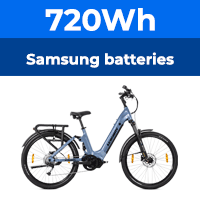I am pleased that you are looking into what the government is doing to help Rolls Royce building the first SMR. If you want to create a new industry, government subsidies are a must.
Prices of the electricity we use to charge
- Thread starter flecc
- Start date
I can't understand why we haven't been doing that stuff for the last fifteen or twenty years.I am pleased that you are looking into what the government is doing to help Rolls Royce building the first SMR. If you want to create a new industry, government subsidies are a must.
Same with housing. If you build in factories you have a controlled environment and can build far faster and more accurately, using modular construction. Everything is repeatable and controlled.
Edit:
In terms of small reactors, you could place them near large demand centres and supply baseload power. This would maybe lessen the need for grid reconstruction and new power lines. Security may be an issue - since they are nuclear.
One issue in relation to complimenting renewable power sources is that traditional nuclear, like coal, needs to be kept hot and on stream, or you get severe penalties from cycling hot and cold. The old coal stations were badly impacted by that, necessitating much earlier major refurbishment than if they were kept working at high capacity. I don't know how SMR technology copes with heat stresses. They might not be suitable to come on and turn off as rapidly as combined cycle gas turbines which don't care about that, and can come on stream rapidly when demand peaks of when renewables drop off the grid.
Last edited:
The same issue affects SMRs because they are based on the same principle of turning thermal energy into electricity. If you look at Bill Gates' Natrium project, their reactor keeps a large tank of molten salt as a buffer.One issue in relation to complimenting renewable power sources is that traditional nuclear, like coal, needs to be kept hot and on stream, or you get severe penalties from cycling hot and cold. The old coal stations were badly impacted by that, necessitating much earlier major refurbishment than if they were kept working at high capacity. I don't know how SMR technology copes with heat stresses. They might not be suitable to come on and turn off as rapidly as combined cycle gas turbines which don't care about that, and can come on stream rapidly when demand peaks of when renewables drop off the grid.
ChatGPT sees the future for SMRs as follows:
- Best-case: SMRs are the “Tesla of nuclear” → modular, exported, widespread by 2035.
- Worst-case: SMRs are the “Concorde of nuclear” → brilliant tech, but too costly, limited adoption.
- Most likely: Somewhere in between — successful in niches, but not a global game-changer.
Current state of SMR projects around the world:
| Country | Leading SMR Designs | Status (2025) | Strategic Goal |
|---|---|---|---|
| Russia | RITM-200, Akademik Lomonosov | Operational | Arctic, export |
| China | ACP100, HTR-PM | Near-term deploy | Scale & export |
| USA | NuScale, Natrium, Xe-100 | Regulatory lead | Renewables pairing |
| UK | Rolls-Royce SMR | Design stage | Energy security, export |
| Canada | GE-Hitachi BWRX-300, ARC, Moltex | Deployment 2029 | Domestic + export |
| Argentina | CAREM | Prototype build | Latin America |
| S. Korea | SMART | Export focus | Middle East clients |
- Russia & China are the only countries with operating SMRs.
- Canada & USA are closest to real Western deployment.
- UK is betting heavily on Rolls-Royce SMRs.
- Argentina & South Korea are pursuing niche/exports.
Last edited:
Have they started construction on UK's three, 3, smr's?The same issue affects SMRs because they are based on the same principle of turning thermal energy into electricity. If you look at Bill Gates' Natrium project, their reactor keeps a large tank of molten salt as a buffer.
ChatGPT sees the future for SMRs as follows:
Our Rolls Royce SMR projects will probably amount to not very much because when you compare the scale and breadth of subsidies that China has put into renewables while our governments will still be cash strapped for the foreseeable future, I can't see Rolls Royce offering customers attractive pricing anytime before 2060s if ever. The best estimates for SMRs are £80 per MWH against £30 per MWH for solar and wind, £40 per MWH on dispatchable basis (renewables + storage battery). That hasn't stopped enthusiam for RR shares because of potential export market. RR shares went up 1,000% last year.
- Best-case: SMRs are the “Tesla of nuclear” → modular, exported, widespread by 2035.
- Worst-case: SMRs are the “Concorde of nuclear” → brilliant tech, but too costly, limited adoption.
- Most likely: Somewhere in between — successful in niches, but not a global game-changer.
Current state of SMR projects around the world:
Country Leading SMR Designs Status (2025) Strategic Goal Russia RITM-200, Akademik Lomonosov Operational Arctic, export China ACP100, HTR-PM Near-term deploy Scale & export USA NuScale, Natrium, Xe-100 Regulatory lead Renewables pairing UK Rolls-Royce SMR Design stage Energy security, export Canada GE-Hitachi BWRX-300, ARC, Moltex Deployment 2029 Domestic + export Argentina CAREM Prototype build Latin America S. Korea SMART Export focus Middle East clients
- Russia & China are the only countries with operating SMRs.
- Canada & USA are closest to real Western deployment.
- UK is betting heavily on Rolls-Royce SMRs.
- Argentina & South Korea are pursuing niche/exports.
No, zero, net zero..
How long does it take to build an smr?
Err...
Thought so!
Related Articles
-
 MTF Enterprises announces acquisition of EMU Electric Bikes
MTF Enterprises announces acquisition of EMU Electric Bikes- Started by: Pedelecs
-
 Wisper 806T folding bike wins Which? ‘Best Buy’
Wisper 806T folding bike wins Which? ‘Best Buy’- Started by: Pedelecs
-
 Sustrans calls for protected cycle lanes
Sustrans calls for protected cycle lanes- Started by: Pedelecs
-
 Amazon launch their first UK e-cargo micromobility hub
Amazon launch their first UK e-cargo micromobility hub- Started by: Pedelecs



